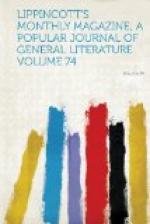Miss Adamson, the normal-school young lady recommended, wrote thus to Lady Arthur:
“MADAM: I am very much tempted to take the situation you offer me. If I were teacher of a village school, as I had intended, when my work in the school was over I should have had my time to myself; and I wish to stipulate that when the hours of teaching Miss Garscube are over I may have the same privilege. If you engage me, I think, so far as I know myself, you will not be disappointed.
“I am,” etc. etc.
To which Lady Arthur:
“So far as I can judge,
you are the very thing I want. Come,
and we shall not disagree
about terms,” etc. etc.
Thus it came about that Miss Garscube was unusually lucky in the matter of her education and Miss Adamson in her engagement. Although eccentric to the pitch of getting credit for being daft, Lady Arthur had a strong vein of masculine sense, which in all essential things kept her in the right path. Miss Adamson and she suited each other thoroughly, and the education of the two ladies and the child may be said to have gone on simultaneously. Miss Adamson had an absorbing pursuit: she was an embryo artist, and she roused a kindred taste in her pupil; so that, instead of carrying on her work in solitude, as she had expected to do, she had the intense pleasure of sympathy and companionship. Lady Arthur often paid them long visits in their studio; she herself sketched a little, but she had never excelled in any single pursuit except horsemanship, and that she had given up at her husband’s death, as she had given up keeping much company or going often into society.
In this quiet, unexciting, regular life Lady Arthur’s antiquarian tastes grew on her, and she went on writing poetry, the quantity of which was more remarkable than the quality, although here and there in the mass of ore there was an occasional sparkle from fine gold (there are few voluminous writers in which this accident does not occur). She superintended excavations, and made prizes of old dust and stones and coins and jewelry (or what was called ancient jewelry: it looked ancient enough, but more like rusty iron to the untrained eye than jewelry) and cooking utensils supposed to have been used by some noble savages or other. Of these and such like she had a museum, and she visited old monuments and cairns and Roman camps and Druidical remains and old castles, and all old things, with increasing interest. There were a number of places near or remote to which she was in the habit of making periodical pilgrimages—places probably dear to her from whim or association or natural beauty or antiquity. When she fixed a time for such an excursion, no weather changed her purpose: it might pour rain or deep snow might be on the ground: she only put four horses to her carriage instead of two, and went on her way. She was generally accompanied




